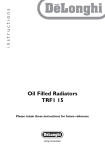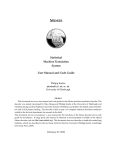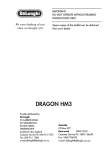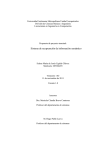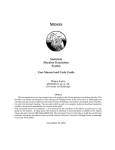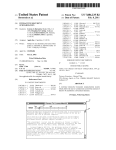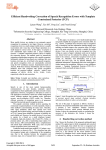Download IRST Language Modeling Toolkit Version 5.20.00 USER MANUAL
Transcript
IRST Language Modeling Toolkit
Version 5.20.00
USER MANUAL
M. Federico, N. Bertoldi, M. Cettolo
FBK-irst, Trento, Italy
September 11, 2008
1
Introduction
The IRST Language Modeling Toolkit features algorithms and data structures suitable to estimate, store, and
access very large LMs. Our software has been integrated into a popular open source SMT decoder called
Moses.1
Acknowledgments. Users of this toolkit might cite in their publications:
M. Federico, N. Bertoldi, M. Cettolo, IRSTLM: an Open Source Toolkit for Handling Large
Scale Language Models, Proceedings of Interspeech, Brisbane, Australia, 2008.
References to introductory material on n-gram LMs are given in the appendix.
2
Getting started
Environment Settings Commands and scripts described in this manual are installed under the directories bin and bin/$MACHTYPE, that we assume are included in your PATH environment variable. If the
evironment variable MACHTYPE is not already set, it will be set by means of the command"uname -m".
You need also to set the environment variable IRSTLM to the path of this package. Data sets used in the
examples can be found in the example directory.
Examples The directory example contains two English text files, namely train.gz and test, which
we will use to estimate and evaluate our LM, respectively. In particular, LM evaluation computes both the
perplexity and the out-of-vocabulary rate of the test set. Notice that both file are tokenized and contain
one sentence per line and sentence boundary symbols. Given a text file, sentence boundary symbols can be
added in each line with the script add-start-end.sh:
$> add-start-end.sh < your-text-file
1
http://www.statmt.org/moses/
1
3
Estimating Gigantic LMs
LM estimation starts with the collection of n-grams and their frequency counters. Then, smoothing parameters are estimated for each n-gram level; infrequent n-grams are possibly pruned and, finally, a LM file is
created containing n-grams with probabilities and back-off weights. This procedure can be very demanding
in terms of memory and time if it applied on huge corpora. We provide here a way to split LM training
into smaller and independent steps, that can be easily distributed among independent processes. The procedure relies on a training scripts that makes little use of computer RAM and implements the Witten-Bell
smoothing method in an exact way.
Before starting, let us create a working directory under examples, as many files will be created:
$> mkdir stat
The script to generate the LM is:
> build-lm.sh -i "gunzip -c train.gz" -n 3
-o train.ilm.gz -k 5
where the available options are:
-i
-o
-k
-n
-t
-p
-s
-b
-d
-v
Input training file e.g. ’gunzip -c train.gz’
Output gzipped LM, e.g. lm.gz
Number of splits (default 5)
Order of language model (default 3)
Directory for temporary files (default ./stat)
Prune singleton n-grams (default false)
Smoothing methods: witten-bell (default), kneser-ney
Include sentence boundary n-grams (optional)
Define subdictionary for n-grams (optional)
Verbose
The script splits the estimation procedure into 5 distinct jobs, that are explained in the following section.
There are other options that can be used. We recommend for instance to use pruning of singletons to get
smaller LM files. Notice that build-lm.sh produces a LM file train.ilm.gz that is NOT in the
final ARPA format, but in an intermediate format called iARPA, that is recognized by the compile-lm
command and by the Moses SMT decoder running with IRSTLM. To convert the file into the standard ARPA
format you can use the command:
> compile-lm train.ilm.gz --text yes train.lm
this will create the proper ARPA file lm-final. To create a gzipped file you might also use:
> compile-lm train.ilm.gz --text yes /dev/stdout | gzip -c > train.lm.gz
In the following sections, we will talk about LM file formats, compiling your LM into a more compact and
efficient binary format, and about querying your LM.
2
3.1
Estimating a LM with a Partial Dictionary
We can extract the corpus dictionary sorted by frequency with the command:
$> dict -i="gunzip -c train.gz" -o=dict -f=y -sort=no
A sub-dictionary can be defined by just taking words occurring at least 5 times:
$> (echo DICTIONARY; tail +2 dict | awk ’{if ($2>=5) print}’) > sdict
The LM can be restricted to the defined sub-dictionary with the command build-lm.sh by using the
option -d:
> build-lm.sh -i "gunzip -c train.gz" -n 3
-o sublm.gz -k 5 -p -d sdict
Notice that, all words outside the sub-dictionary will be mapped to the <unk> class, the probability of
which will be directly estimated from the corpus statistics.
4
LM File Formats
This toolkit supports three output format of LMs. These formats have the purpose of permitting the use of
LMs by external programs. External programs could in principle estimate the LM from an n-gram table
before using it, but this would take much more time and memory! So the best thing to do is to first estimate
the LM, and then compile it into a binary format that is more compact and that can be quickly loaded and
queried by the external program.
4.1
ARPA Format
This format was introduced in DARPA ASR evaluations to exchange LMs. ARPA format is also supported
by the SRI LM Toolkit. It is a text format which is rather costly in terms of memory. There is no limit to the
size n of n-grams.
4.2
qARPA Format
This extends the ARPA format by including codebooks that quantize probabilities and back-off weights of
each n-gram level. This format is created through the command quantize-lm.
4.3
iARPA Format
This is an intermediate ARPA format in the sense that each entry of the file does not contain in the first
position the full n-gram probability, but just its smoothed frequency, i.e.:
...
f(z|x y) x y z bow(x y)
...
This format is nevertheless properly managed by the compile-lm command in order to generate a binary
version or a correct ARPA version.
3
4.4
Binary Formats
Both ARPA and qARPA formats can be converted into a binary format that allows for space savings on
disk and a much quickers upload of the LM file. Binary versions can be created with the command
compile-lm, that produces files with headers blmt or Qblmt.
5
LM Pruning
Large LMs files can be pruned in a smart way by means of the command prune-lm that removes n-grams
for which resorting to the back-off results in a small loss. The syntax is as follows:
> prune-lm --threshold=1e-6,1e-6
train.lm.gz
train.plm
Thresholds for each n-gram level, up from 2-grams, are based on empirical evidence. Threshold zero results
in no pruning. If less thresholds are specified, the right most is applied to the higher levels. Hence, in the
above example we could have just specified one threshold, namely --threshold=1e-6. The effect of
pruning is shown in the following messages of prune-lm:
1-grams: reading 15059 entries
2-grams: reading 142684 entries
3-grams: reading 293685 entries
done
OOV code is 15058
OOV code is 15058
pruning LM with thresholds:
1e-06 1e-06
savetxt: train.lm.plm
save: 15059 1-grams
save: 135967 2-grams
save: 185127 3-grams
The saved LM table train.plm contains about 5% less bigrams, and 37% less trigrams! Notice that
the output of prune-lm is an ARPA LM file, while the input can be either an ARPA or binary LM. Notice
that quantization must be eventually performed after pruning! In order to measure the loss in accuracy
introduced by pruning, perplexity of the resulting LM can per computed (see below).
6
LM Quantization and Compilation
A language model file in ARPA format, created with the IRST LM toolkit or with other tools, can be quantized and stored in a compact data structure, called language model table. Quantization can be performed
by the command:
$> quantize-lm
train.lm train.qlm
which generates the quantized version train.qlm that encodes all probabilities and back-off weights in 8
bits. The output is a modified ARPA format, called qARPA.
LMs in ARPA or qARPA format can be stored in a compact binary table through the command:
4
$> compile-lm train.lm tran.blm
which generates the binary file train.blm that can be quickly loaded in memory.
7
LM Interface
LMs are useful when they can be queried through another application in order to compute perplexity scores
or n-gram probabilities. IRSTLM provides two possible interfaces:
• at the command level, through compile-lm
• at the c++ library level, mainly through methods of the class lmtable
In the following, we will only focus on the command level interface. Details about the c++ library interface
will be provided in a future version of this manual.
7.1
Perplexity Computation
To compute the perplexity directly from the LM on disk, we can use the command:
$> compile-lm train.lm --eval=test
Nw=49984 PP=474.90 PPwp=0.00 Nbo=39847 Noov=2503 OOV=5.01%
Notice that PPwp reports the contribution of OOV words to the perplexity: each OOV word is penalized
by a fixed OOV penalty. By default, OOV penalty is 0. OOV penalty can be modify by setting a dictionary
upper-bound with --dub. Indeed:
$> compile-lm train.lm --eval=test --dub=10000000
Nw=49984 PP=1064.40 PPwp=589.50 Nbo=39847 Noov=2503 OOV=5.01%
The perplexity of the pruned LM can be computed with the command:
compile-lm train.plm --eval test --dub 10000000
Nw=49984 PP=1019.57 PPwp=564.67 Nbo=42671 Noov=2503 OOV=5.01%
Interestingly, a slightly better value is obtained which could be explained by the fact that pruning has removed many unfrequent trigrams and has redistributed their probabilities over more frequent bigrams.
7.2
Probability Computations
We can compute as well log-probabilities word-by-word from standard input with the command:
$> compile-lm train.lm --score yes < test
>
>
>
>
>
</s> 1 p= NULL
</s> <s>
1 p= NULL
</s> <s> <unk>
1 p= -6.130331e+00 bo= 2
<s> <unk> of 1 p= -3.530050e+00 bo= 2
<unk> of the 1 p= -1.250671e+00 bo= 1
5
> of the senate 1 p= -8.805695e+00 bo= 0
> the senate ( 1 p= -6.150410e+00 bo= 2
> senate ( <unk>
1 p= -5.547798e+00 bo= 2
....
....
the commands reports the currently observed n-gram, including unk words, a dummy constant frequency
1, the log-probability of the n-gram, and the number of back-offs performed by the LM.
Finally, tracing information with the --eval option are shown by setting debug levels from 1 to 4
(--debug):
1 reports the back-off level for each word
2 adds the log-prob
3 adds the back-off weight
4 check if probabilities sum up to 1.
8
Parallel Computation
This package provides facilities to build a gigantic LM in parallel in order to reduce computation time. The
script implementing this feature is based on the SUN Grid Engine software2 .
To apply the parallel computation run the following script (instead of build-lm.sh):
> build-lm-qsub.sh -i "gunzip -c train.gz" -n 3
-o train.ilm.gz -k 5
Besides the options of build-lm.sh, parameters for the SGE manager can be provided through the
following one:
-q
parameters for qsub, e.g. "-q <queue>", "-l <resources>"
The script performs the same split-and merge policy described in Section 3, but some computation is performed in parallel (instead of sequentially) distributing the tasks on several machines.
A
Reference Material
The following books contain basic introductions to statistical language modeling:
• Spoken Dialogues with Computers, by Renato DeMori, chapter 7.
• Speech and Language Processing, by Dan Jurafsky and Jim Martin, chapter 6.
• Foundations of Statistical Natural Language Processing, by C. Manning and H. Schuetze.
• Statistical Methods for Speech Recognition, by Frederick Jelinek.
• Spoken Language Processing, by Huang, Acero and Hon.
2
http://www.sun.com/software/gridware
6
B
Release Notes
B.1
Version 3.2
• Quantization of probabilities
• Efficient run-time data structure for LM querying
• Dismissal of MT output format
B.2
Version 4.2
• Distinction between open source and internal Irstlm tools
• More memory efficient versions of binarization and quantization commands
• Memory mapping of run-time LM
• Scripts and data structures for the estimation and handling of gigantic LMs
• Integration of IRSTLM into Moses Decoder
B.3
Version 5.00
• Fixed bug in the documentation
• General script build-lm.sh for the estimation of large LMs.
• Management of iARPA file format.
• Bug fixes
• Estimation of LM over a partial dictionary.
B.4
Version 5.04
• Parallel estimation of gigantic LM through SGE
• Better management of sub dictionary with build-lm.sh
• Minor bug fixes
B.5
Version 5.05
• (Optional) computation of OOV penalty in terms of single OOV word instead of OOV class
• Extended use of OOV penalty to the standard input LM scores of compile-lm.
• Minor bug fixes
7
B.6
Version 5.10
• Extended ngt to compute statistics for approximated Kneser-Ney smoothing
• New implementation of approximated Kneser-Ney smoothing method
• Minor bug fixes
• More to be added here ....
B.7
Version 5.20
• Improved tracing of back-offs
• Added command prune-lm (thanks to Fabio Brugnara)
• Extended lprob function to supply back-off weight/level information
• Improved back-off handling of OOV words with quantized LM
• Added more debug modalities to compile-lm
• Fixed minor bugs in regression tests
8








